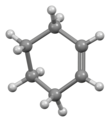Cyclohexeneis ahydrocarbonwith the formula(CH2)4C2H2.It is an example of acycloalkene.At room temperature, cyclohexene is a colorlessliquidwith a sharp odor. Among its uses, it is anintermediatein the commercial synthesis ofnylon.[3]
| |||
| |||
| Names | |||
|---|---|---|---|
| Preferred IUPAC name
Cyclohexene | |||
| Other names
Tetrahydrobenzene, 1,2,3,4-Tetrahydrobenzene, Benzenetetrahydride, Cyclohex-1-ene, Hexanaphthylene, UN 2256
| |||
| Identifiers | |||
3D model (JSmol)
|
|||
| 906737 | |||
| ChEBI | |||
| ChEMBL | |||
| ChemSpider | |||
| ECHA InfoCard | 100.003.462 | ||
| EC Number |
| ||
| 1659 | |||
PubChemCID
|
|||
| RTECS number |
| ||
| UNII | |||
CompTox Dashboard(EPA)
|
|||
| |||
| |||
| Properties | |||
| C6H10 | |||
| Molar mass | 82.143 g/mol | ||
| Appearance | colorless liquid | ||
| Odor | sweet | ||
| Density | 0.8110 g/cm3 | ||
| Melting point | −103.5 °C (−154.3 °F; 169.7 K) | ||
| Boiling point | 82.98 °C (181.36 °F; 356.13 K) | ||
| slightly soluble in water | |||
| Solubility | miscible with organic solvents | ||
| Vapor pressure | 8.93 kPa (20 °C)
11.9 kPa (25 °C) | ||
| 0.022 mol·kg−1·bar−1 | |||
| -57.5·10−6cm3/mol | |||
Refractive index(nD)
|
1.4465 | ||
| Hazards | |||
| GHSlabelling: | |||
    
| |||
| Danger | |||
| H225,H302,H305,H311,H411 | |||
| P210,P233,P240,P241,P242,P243,P264,P270,P273,P280,P301+P310,P301+P312,P302+P352,P303+P361+P353,P312,P322,P330,P331,P361,P363,P370+P378,P391,P403+P235,P405,P501 | |||
| NFPA 704(fire diamond) | |||
| Flash point | −12 °C (10 °F; 261 K) | ||
| 244 °C (471 °F; 517 K) | |||
| Explosive limits | 0.8–5 % | ||
| Lethal doseor concentration (LD, LC): | |||
LD50(median dose)
|
1407 mg/kg (oral, rat) | ||
LCLo(lowest published)
|
13,196 ppm (mouse, 2 hr)[2] | ||
| NIOSH(US health exposure limits): | |||
PEL(Permissible)
|
TWA 300 ppm (1015 mg/m3)[1] | ||
REL(Recommended)
|
TWA 300 ppm (1015 mg/m3)[1] | ||
IDLH(Immediate danger)
|
2000 ppm[1] | ||
| Safety data sheet(SDS) | External MSDS | ||
Except where otherwise noted, data are given for materials in theirstandard state(at 25 °C [77 °F], 100 kPa).
| |||
Production and uses
editCyclohexene is produced by the partialhydrogenationofbenzene,a process developed by theAsahi Chemicalcompany.[4]The main product of the process is cyclohexane because cyclohexene is more easily hydrogenated than benzene.
In the laboratory, it can be prepared bydehydrationofcyclohexanol.[5]
- C6H11OH → C6H10+ H2O
Reactions and uses
editBenzene is converted tocyclohexylbenzeneby acid-catalyzed alkylation with cyclohexene.[6]Cyclohexylbenzene is a precursor to both phenol and cyclohexanone.[7]
Hydration of cyclohexene givescyclohexanol,which can bedehydrogenatedto givecyclohexanone,a precursor tocaprolactam.[8]
Theoxidative cleavageof cyclohexene givesadipic acid.Hydrogen peroxideis used as the oxidant in the presence of a tungsten catalyst.[9]
1,5-Hexadieneis produced byethenolysisof cyclohexene. Bromination gives 1,2-dibromocyclohexane.[10]
Structure
editCyclohexene is most stable in a half-chairconformation,[11]unlike the preference for a chair form ofcyclohexane.One basis for thecyclohexane conformationalpreference for a chair is that it allows each bond of the ring to adopt astaggered conformation.For cyclohexene, however, the alkene is planar, equivalent to an eclipsed conformation at that bond.
See also
editReferences
edit- ^abcNIOSH Pocket Guide to Chemical Hazards."#0167".National Institute for Occupational Safety and Health(NIOSH).
- ^"Cyclohexene".Immediately Dangerous to Life or Health Concentrations (IDLH).National Institute for Occupational Safety and Health(NIOSH).
- ^Xie, Feng; Chen, Lihang; Cedeño Morales, Eder Moisés; Ullah, Saif; Fu, Yiwen; Thonhauser, Timo; Tan, Kui; Bao, Zongbi; Li, Jing (2024)."Complete separation of benzene-cyclohexene-cyclohexane mixtures via temperature-dependent molecular sieving by a flexible chain-like coordination polymer".Nature Communications.15(1): 2240.Bibcode:2024NatCo..15.2240X.doi:10.1038/s41467-024-46556-6.PMC10933443.PMID38472202.
- ^US 9771313,Narisawa, Naoki & Tanaka, Katsutoshi, "Cyclohexanol, method for producing cyclohexanol, and method for producing adipic acid", published 26 Sep 2017
- ^G. H. Coleman, H. F. Johnstone (1925). "Cyclohexene".Organic Syntheses.5:33.doi:10.15227/orgsyn.005.0033.
- ^B. B. Corson, V. N. Ipatieff (1939). "Cyclohexylbenzene".Organic Syntheses.19:36.doi:10.15227/orgsyn.019.0036.
- ^Plotkin, Jeffrey S. (2016-03-21)."What's New in Phenol Production?".American Chemical Society. Archived fromthe originalon 2019-10-27.Retrieved2018-01-02.
- ^Musser, Michael T. (2005). "Cyclohexanol and Cyclohexanone".Ullmann's Encyclopedia of Industrial Chemistry.Weinheim: Wiley-VCH.doi:10.1002/14356007.a08_217.ISBN978-3-527-30673-2.
- ^Reed, Scott M.; Hutchison, James E. (2000). "Green Chemistry in the Organic Teaching Laboratory: An Environmentally Benign Synthesis of Adipic Acid".J. Chem. Educ.77(12):1627–1629.Bibcode:2000JChEd..77.1627R.doi:10.1021/ed077p1627.
- ^H. R. Snyder, L. A. Brooks (1932). "1,2-Dibromocyclohexane".Organic Syntheses.12:26.doi:10.15227/orgsyn.012.0026.
- ^Jensen, Frederick R.; Bushweller, C. Hackett (1969). "Conformational preferences and interconversion barriers in cyclohexene and derivatives".J. Am. Chem. Soc.91(21):5774–5782.doi:10.1021/ja01049a013.
External links
edit- International Chemical Safety Card 1054
- NIOSH Pocket Guide to Chemical Hazards."#0167".National Institute for Occupational Safety and Health(NIOSH).
- Material Safety Data Sheet for cyclohexene
- Safety MSDS data
- Reaction of Cyclohexene with Bromine and Potassium Permanganate
- Cyclohexene synthesis
- Data sheet at inchem.org




